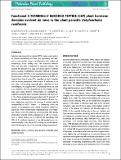Functional C-terminally Encoded Peptide (CEP) plant hormone domains evolved de novo in the plant parasite Rotylenchulus reniformis
Abstract
Sedentary Plant-Parasitic Nematodes (PPNs) induce and maintain an intimate relationship with their host, stimulating cells adjacent to root vascular tissue to re-differentiate into unique and metabolically active “feeding sites”. The interaction between PPNs and their host is mediated by nematode effectors. We describe the discovery of a large and diverse family of effector genes, encoding C-terminally Encoded Peptide (CEP) plant hormone mimics (RrCEPs), in the syncytia-forming plant-parasite Rotylenchulus reniformis. The particular attributes of RrCEPs distinguish them from all other CEPs, regardless of origin. Together with the distant phylogenetic relationship of R. reniformis to the only other CEP-encoding nematode genus identified to date (Meloidogyne), this suggests CEPs likely evolved de novo in R. reniformis. We have characterised the first member of this large gene family (RrCEP1), demonstrating its significant upregulation during the plant-nematode interaction and expression in the effector-producing pharyngeal gland cell. All internal CEP domains of multi-domain RrCEPs are followed by di-basic residues, suggesting a mechanism for cleavage. A synthetic peptide corresponding to RrCEP1 domain 1 is biologically active and capable of upregulating plant nitrate transporter (AtNRT2.1) expression, while simultaneously reducing primary root elongation. When a non-CEP containing, syncytia-forming PPN species (Heterodera schachtii) infects Arabidopsis in a CEP-rich environment a smaller feeding site is produced. We hypothesise that CEPs of R. reniformis represent a two-fold adaptation to sustained biotrophy in this species; 1) increasing host nitrate uptake while 2) limiting the size of the syncytial feeding site produced.
Citation
Eves-van den Akker , S , Lilley , C J , Yusup , H B , Jones , J T & Urwin , P E 2016 , ' Functional C-terminally Encoded Peptide (CEP) plant hormone domains evolved de novo in the plant parasite Rotylenchulus reniformis ' , Molecular Plant Pathology , vol. 17 , no. 8 , pp. 1265-1275 . https://doi.org/10.1111/mpp.12402
Publication
Molecular Plant Pathology
Status
Peer reviewed
ISSN
1364-3703Type
Journal article
Description
This work was supported by the Biotechnology and Biological Sciences Research Council (BBSRC) and The James Hutton Institute through a PhD studentship to SE-vdA. The James Hutton Institute receives funding from the Scottish Government Rural and Environment Science and Analytical Services division. SE-vdA is supported by BBSRC grant BB/M014207/1.Collections
Items in the St Andrews Research Repository are protected by copyright, with all rights reserved, unless otherwise indicated.

